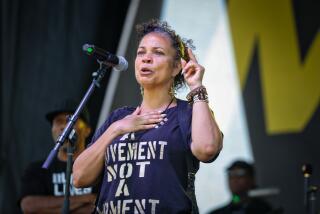Witness in hate crime trial errs
- Share via
A key witness in the trial of 10 black youths accused of viciously attacking three white women in Long Beach on Halloween night was unable Thursday to identify one of the girls she had implicated in the beatings.
Shortly after the youths -- nine girls and one boy -- were arrested, the witness, Kiana Alford, identified them and told police what she saw each one do during the attacks. Asked to pick one of them out in the courtroom Thursday, she confidently pointed to a girl. But it was the wrong one.
Defense attorneys seized on the error as evidence that Alford could not tie the defendants to specific acts of violence.
The case has gained national attention and become fodder for talk radio, given the inflammatory implications of an alleged black-on-white hate crime. The trial began Tuesday afternoon in the Long Beach courtroom of Superior Court Judge Gibson Lee and has proceeded slowly, with Alford, 18, the sole witness to take the stand so far.
Each of the 10 defendants is charged with three felony counts of assault with intent to cause great bodily injury, and eight with a hate crime enhancement. One of the women reportedly suffered 12 facial fractures and may have lost some eyesight.
Alford testified Wednesday that she saw each of the 10 defendants -- ages 12 to 17 and including one of the nation’s top young track athletes -- take part in a brutal mob beating and then leave in two cars. Her testimony has been sharp and unhesitating.
But her first day of cross-examination by the defense team Thursday illustrated the difficulty prosecutors might have in getting convictions.
Alford has testified that at least two dozen people jumped the women. Defense attorneys are questioning how she could recall what each of 10 people, whom she had never seen before, did during such a chaotic moment.
Alford said she went to Linden Avenue in the upscale Bixby Knolls area on Halloween to take her 1-year-old daughter trick-or-treating with her 14-year-old sister and an 18-year-old friend. The street is known for elaborate displays and haunted houses, and draws hundreds of people every year.
Alford said she decided to leave when two black girls, among a crowd of more than 30 in front of a haunted house, greeted her in a threatening manner. Alford also is black.
Alford’s group got back into her car and began to drive away. She saw three white women -- two age 19, one age 21, -- file through the crowd.
She described subsequently seeing a commotion, hearing a boy and girl utter racial slurs, and then watching as a number of people began throwing lemons and small pumpkins at the women. The trio tried to walk away, Alford said, but two black girls began attacking one of them. Others quickly joined the fray until eight to 10 youths were pummeling each of the white women.
On Wednesday, Alford said she saw this unfolding and jumped out of her car to help. But on cross-examination Thursday, she indicated that she had waited in her car, several houses away from the beating, until a good Samaritan dispersed the assailants.
But the biggest dispute of the day was over the courtroom identification.
The 10 defendants in the two cars were arrested soon after the attack in a parking lot. Alford testified that police officers brought her to the lot and had her sit in the patrol car as the minors were brought one by one into the headlights. She told officers she recognized each one, and described what they did during the beatings. The officers created separate statements on each defendant, attached photos and had her sign them.
In court Thursday, defense attorneys wanted Alford, without the help of photos or police statements, to point to each minor in court and describe what she saw them do.
But Deputy Dist. Atty. Andrea Bouas argued that Alford’s parking lot identifications were largely based on what the youths were wearing.
“Whatever she does in court, it’s the strength of that first identification that is the basis of this case,” she said. “Who knows if she’s going to recognize all of these girls. They’re all in gray.... None of the clothing and distinguishing characteristics.”
Judge Lee allowed Alford to authenticate her statements and the police photos. Bouas then asked her to point out defendants in the courtroom. Alford got it right twice. But when on the third try she pointed to the wrong girl, Bouas stopped asking for individual identifications.
Suspecting that the witness may have been told to memorize where each girl was sitting, defense attorneys had moved some of them around Thursday.
“It strictly had to do with positioning,” said defense lawyer Kathleen Moreno, whose client was misidentified.
More to Read
Sign up for Essential California
The most important California stories and recommendations in your inbox every morning.
You may occasionally receive promotional content from the Los Angeles Times.














